At Last: A Forthright Panhandler

I love this picture that I took at the Cornerstone Music Festival five or so years ago. I thought I had lost it, but when I recently upgraded to iPhoto 6, the software scanned my directories and "found" about 150 recovered photos, including this one.
This picture was taken about midway through the week. These boys had spent all their money on no telling what, and were asking folks who walked by for their pocket change. I laughed at the candid message on the sign: "Will Do Nothing for Food or Money" and then in smaller print, "Don't give crackers!" Evidently someone had tried. When I walked by, they already had quite a bit of change in their cup. Honesty about their willingness to do nothing was paying off.
I asked if I could take their picture. They said I could for 50¢.
Romans 14:4 in the NLT
I read through the NLT after it was released in 1996, but have never used it extensively for study or teaching. Its dynamic equivalence is a bit too dynamic for my tastes. However, I respect the translators, some of whom I've known personally. Therefore, the NLT is a translation I trust.
Kathy, on the other hand, took to the NLT immediately. If there's ever been a translation that fits someone's personality, the NLT fits Kathy. You'd have to know both of them to understand that statement. I tend to avoid the translation battles. I firmly believe that a person should read the translation that speaks to him or her best. What's the best translation? The one you're willing to read. Of course, I'm speaking in terms of the major current translations, not those that might be on the fringe of reliability.
In comparing her NLT to the other versions, Kathy was struck by how different Rom 14:4 read in her Bible. The NLT always reads a bit differently from other standard translations, but this was different. Note the differences below, especially in the first line.
New Living Translation |
||
| Who are you to condemn God's servants? They are responsible to the Lord, so let him tell them whether they are right or wrong. The Lord's power will help them do as they should. | ||
New American Standard Bible |
Holman Christian Standard Bible |
King James Version |
| Who are you to judge the servant of another? To his own master he stands or falls; and he will stand, for the Lord is able to make him stand. | Who are you to criticize another’s household slave? Before his own Lord he stands or falls. And stand he will! For the Lord is able to make him stand. | Who art thou that judgest another man’s servant? to his own master he standeth or falleth. Yea, he shall be holden up: for God is able to make him stand. |
Greek New Testament |
||
| σὺ τίς εἶ ὁ κρίνων ἀλλότριον οἰκέτην; τῷ ἰδίῳ κυρίῳ στήκει ἢ πίπτει· σταθήσεται δέ, δυνατεῖ γὰρ ὁ κύριος στῆσαι αὐτόν. | ||
The theme of the passage is Paul's admonition against judging each other in gray areas or disputable issues of the Christian faith. In v. 4 he makes an analogy using the example of household slaves. Of the translations represented above, the Holman Christian Standard Bible (HCSB) is the most accurate in the first line because it correctly translates ὀικέτης as "household slave." Paul used this word instead of his more standard word for slave or servant, δοῦλος, because it better suits his analogy. Unfortunately, the HCSB capitalizes the L in "Lord" in the first instance of Paul's use of κύριος. Thus his play on words between a servant's earthly lord and one's heavenly Lord is obscured. The NASB translators more accurately translate the first use as "master." The wordplay itself is lost, but the distinction between the earthly master and the heavenly Master is retained.
But note the NLT's "Who are you to condemn God's servants?" Where did that come from? There was no mention of God in the first line of the other versions. I looked it up in the Greek New Testament, and there was no reference to God there either. Kathy is used to her NLT reading differently from other versions, but I think this was the first time she'd ever doubted its accuracy. I was a bit befuddled, too. That verse taken by itself seemed to be totally mistranslated. I personally know two of the three men who were responsible for translating Romans in the NLT, but I didn't understand why they would translate the verse this way.
I mentally pushed the issue aside and continued to study the passage since I would be teaching it Sunday morning. When I came to bed later Saturday night, I whispered in my sleeping wife's ear, "Your translation is accurate. I'll tell you about it in the morning."
As I continued my study, I eventually understood why the NLT translators presented their verse in this way. The Apostle Paul is making an analogy. In the context of casting judgment on each other over secondary issues, Paul is essentially asking the question, "Would any of you show criticism to another man's servant?" Of course not. It wouldn't be the place of someone to do that in the ancient world. When I taught the passage this morning, I tried to make a modern analogy to being frustrated with rowdy children in public places. Often we are tempted to say something perhaps as a reprimand to them or perhaps to their parents, but we often don't because they aren't our children. This is close to what Paul was saying to the Roman Christians. It wouldn't be fitting to criticize another person's servants because odds are they are fulfilling the will of their master. Paul is stressing that likewise, we belong to God. We are his servants, and it's neither appropriate of us to pass judgment on each other for this disputable issues.
Now I just explained to you what the verse meant. I have interpreted it for you. The NLT translators describe their dynamic-equivalence method as "thought-for-thought." In the preface of the New Living Translation, they describe their method in this way:
...to translate the thought of the original language requires that the text be interpreted accurately and then be rendered in understandable idiom. So the goal of any thought-for-thought translation is to be both reliable and eminently readable. Thus, as a thought-for-thought translation, the New Living Translation seeks to be both exegetically accurate and idiomatically powerful.
When the NLT translators rendered Romans 14:4 as "Who are you to condemn God's servants? They are responsible to the Lord, so let him tell them whether they are right or wrong..." they were taking the interpretive step for the reader and accurately rendering Paul's thought in the passage. The point is about judging God's servants. That may be a bit more than what I personally want my primary translation to do for me, But I can't label it incorrect.
Bigfoot No More

Way back in the nineties, I used a bigfoot.com email forwarding address. I haven't given it out in years because it receives so much spam. As of today, I am no longer letting it forward to my main email account. So if for some reason you STILL have the bigfoot email address associated with my name, please change it (for the love of Margaret) to RMansfield@mac.com.
Update (1/28/06): Not only did I stop forwarding my Bigfoot mail, but I also turned off the forwarding from my Yahoo Mail (which I never give out), AND my forwarding from my InsightBB mail (which is also not ever shared). Guess how much junk mail I had this morning? NONE. I usually have at least half a dozen unwanted emails just by the time I get up in the morning. Not now. Go figure.
Ecumenical Councils at a Glance
325 - 1st Ecumenical Council at Nicea
Heretics: Arius—Jesus was a created by God and not fully God, but a super-human or demi-God.
Heroes: St. Athanasius.
Decision: Established Symbol of Faith (Nicene Creed).
Canons: Determined formula for determining Pascha (Easter). Condemned mandatory celibacy for all ranks of clergy. Determined prayers on Sundays should be offered standing.
381 - 2nd Ecumenical Council at Constantinople
Heretics: Macedonianism, Apollinarians, Eunomians, Eudoxians, Sabellians, Marcellians, Photinians.
Heroes: St. Gregory the Theologian (aka St. Gregory of Nazianzus) and St. Gregory of Nyssa
Decision: Condemned Arianism. Condemned Macedonianism which denied divinity of the Holy Spirit. Defined the Holy Trinity as one God in Three Persons: the Father, the Son, and the Holy Spirit each fully God of the same essence. Expanded Symbol of Faith from Nicaea I into what is now commonly labelled "Nicene Creed" but is more properly known as the Nicene-Constantinopolitan Creed. Condemned Apollinarianism which taught the Lord Jesus Christ possessed the divine Logos in place of a human mind and was therefore fully divine, but not fully human. Condemned Eunomians (an extreme form of Arianism), the Eudoxians (semi-Arians), the Sabellians (who taught the Father, Son, and Holy Spirit were three modes of manifestation of the one God, denying the distinction of Three Persons), the Marcellians (who taught the Logos was an impersonal divine power that issued from God and entered into a relationship with Jesus to make him the Son of God), and the Photinians (who taught that Jesus was a mere man upon whom the Logos rested).
Canons: Ranked relative importance of the five patriarchates with Old Rome first and New Rome (Constantinople) second. Established regulations for church discipline, including standing during prayer on Sundays and the days of Pentecost. Established manner in which heretics were to be received into the Church.
431 - 3rd Ecumenical Council at Ephesus
Heretics: Nestorius
Heroes: St. Cyril of Alexandria
Decision: Condemned Nestorianism which taught a separation between the Lord Jesus Christ's divinity and humanity. Affirmed the term Theotokos. Upheld Christology of Saint Cyril of Alexandria.
Canons: The Symbol of Faith (Nicene-Constantinopolitan Creed) was affirmed and changes to it were forbidden with punishment of deposition for clerics and excommunication for laity prescribed. Established that the rights of each province should be preserved and inviolate (i.e. bishops from one province have no rights over other provinces).
451 - 4th Ecumenical Council at Chalcedon
Heretics: Eutyches
Heroes: St. Leo (the Great) of Rome.
Decision: Condemned Monophysitism. After examination of the Tome of Leo affirmed it as "the faith of the Fathers." Affirmed completeness of the two natures of the Lord Jesus Christ: divinity and humanity (perfect God and perfect man).
Canons: Affirmed canons of previous three Ecumenical (Imperial) Councils. Reaffirmed New Rome (Constantinople) as second in honour (following Old Rome) of the patriarchates.
Statement: “one and the same Christ, Son, Lord, only-begotten, recognised in two natures, without confusion, without change, without division, without separation; the distinction of natures being in no way annulled by the union, but rather the characteristics of each nature being preserved and coming together to form one person and subsistence, not as parted or separated into two persons, but one and the same Son and only-begotten God the Word, Lord Jesus Christ”
553 - 5th Ecumenical Council at Constantinople
Heretics: Theodore of Mopsuestia, Eutyches, and Origen
Heroes: Emperor (Saint) Justinian (the Great)
Decision: Condemned the person and writings of Theodore of Mopsuestia, who had been Nestorius' teacher and declared the Logos to be a different God than the one called Christ and who taught the Lord Jesus Christ was troubled by desires of human flesh and passions of the human soul. Condemned Origen, Didymus, and Evagrius for teaching the pre-existence of souls, re-incarnation, the ultimate salvation of demons, that heavenly bodies possessed souls, and other errors.
680 - 6th Ecumenical Council at Constantinople
Heretics: Monothelitism, representing Sergius, Pyrrhus, Paul, Peter, Pope Honorius, and Cyrus.
Heroes: St. Maximos the Confessor, St. Martin (Pope of Rome)
Decision: Condemned Monothelitism (a belief that the Lord Jesus Christ had only one will and one energy). Affirmed that the Lord Jesus Christ, though but one person, after His incarnation possessed two natural wills and two natural energies, just as He possessed two natures.
787 - 7th Ecumenical Council at Nicea
Heretics: Emperor Leo IV and Constantine V
Heroes: Empress Irene; St. John of Damascus; St. Germanus
Decision: Condemned Iconoclasm. Affirmed veneration (but not adoration, which was for God alone) of images.
Canons: Decreed that those secretly keeping Jewish customs (e.g. keeping the Sabbath) but pretending to be Christians should live as Jews openly, but be excluded from the Church. Established monastic regulations.
Statement: “Whenever these representations are contemplated, they will cause those who look at them to commemorate and love their prototype. We define also that they should be kissed and that they are an object of veneration and honour [timitiki proskynisis], but not of real worship [latreia], which is reserved for Him Who is the subject of our faith and is proper for the Divine Nature. The veneration accorded to an icon is in effect transmitted to the prototype; he who venerates the icon, venerated in it the reality for which it stands.”
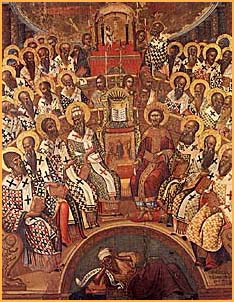
Kudos to Theron for teaching important Christian history at his church.
LINKS:
Theron Mathis can be contacted at TMMATHIS@travelers.com.
For more information on the Ecumenical Councils, you may want to read the Wikipedia article, "Ecumenical Council."
To download Theron's original handout, go to my File Downloads page, select Other, then select Ecumenical Councils.pdf.
iWeb: So Much Ingenuity, So Many Missing Features

In fact, I've created a little test site in iWeb using material from This Lamp. You can check it out yourself at http://web.mac.com/rmansfield/iWeb/Site/Welcome.html. Here is a screenshot of the blog page I made:

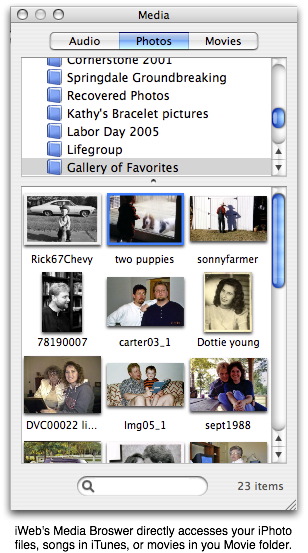
This object oriented, drag and drop ability is perhaps iWeb's greatest strength. It gives you a true WYSIWYG layout that is only limited by your own creativity. The included themes and templates look good by themselves, but you can completely rework them to suit your own tastes. Objects can be placed on top of one another. In fact, I find it interesting to watch the pages "build" when I view them in Safari. Masking tools are included as well so that only part of your images show or you can conform them to predesigned shapes. I currently use RapidWeaver for my website, and I can honestly say that iWeb beats RapidWeaver hands down in the abilities described above.
The interface for iWeb has more in common with Pages and Keynote than then other applications in iLife suite, right down to the Inspector. I've read elsewhere that iWeb was originally supposed to be included in iWork '06, but was switched over to iLife instead. Good idea. It will definitely get more exposure with iLife.
iWeb comes with a number of nicely designed themes and six basic template pages, although I'm not really sure that a welcome page is all that necessary on any site. On This Lamp, the default "home" page is simply my blog. However in the test iWeb site I created (see link above), I did make a welcome page for demonstration purposes.
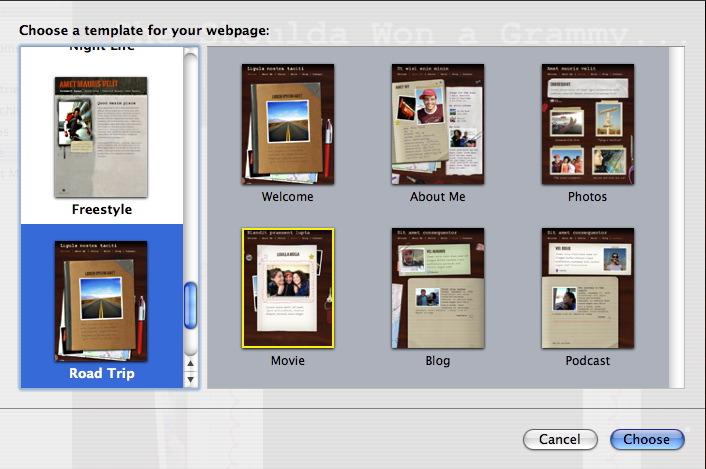
iWeb seems to be most at home publishing to a .Mac account, but can actually publish to any server. However, certain features like the hit counters don't work outside of .Mac. Why that is I don't know, and unfortunately, you cannot currently add third party counters.
All in all, iWeb is an extremely powerful website building program that is simple and intuitive enough to use that anyone can have a website up and running in a very short period of time. Unfortunately, a number of glaring feature oversights will keep the more experienced website creator from forgetting that this is a version 1.0 program.
The most telling deficiencies are in the blogging template. And these lacking features will be enough to frustrate anyone who has blogged with other software. Here's the short list:
• No categories.
• No ability to incorporate comments or trackbacks, although some ingenious workarounds are starting to appear. See this description on Apple's discussion boards.
• No ability to include direct snippets of HTML code or edit the HTML code at all outside of opening the generated files in another program. However, any such hacked changes will be lost the next time you publish from iWeb. That means no blog rolls, no Google or Amazon ads, no third party counters, no sidebar polls, etc.
• No sidebars. Although some of the blog templates give the illusion of a separate sidebar or frame, essentially they do not.
However, iWeb has RapidWeaver beat by allowing blog entries to be viewed on their own page, thus creating true permalinks, something that RapidWeaver does not do yet (much to my frustration, RapidWeaver only designates unique entry ID's for blogs, but not true permalinks that direct to a separate page; I manually create the permlinks at the end of each blog).
Further, some basic templates that are available in the .Mac Homepage editor are missing such as a page for file downloads. Of course, you could always take an About Me page and clear the objects and then add links, but this would not be anywhere near the ease of the current .Mac Homepage implementation where you simply drop files in your iDisk's public folder. I've even kept this feature in RapidWeaver by adding a frame around my original Homepage file download template.
One important drawback...once you choose a particular template theme, you'd better like it because it can't be changed! This limitation doesn't make good sense to me, although I suppose it has to do with the fact that many of the elements inherent to a template are extremely specific to that theme. Evidently, they wouldn't transfer well to a different theme. However, I will freely suggest that one of RapidWeaver's strengths is that you CAN change your theme anytime and give your site a whole new look. But again, RapidWeaver themes will probably not have the number of elements available for editing or even deleting that iWeb does.
Whenever I look at software that duplicates the functions of an application I'm already using, I ask myself what it would take for me to switch. I mean I'm not beyond switching considering I moved 140+ blog entries last Fall from iBlog to RapidWeaver (of course now I am pushing 230 entries). The drag and drop design capabilities of iWeb tugs at my creative heart. However, the list of features described above is the dealbreaker for me.
I have no doubt that Apple will improve iWeb over time. Unfortunately, the only iLife program that gets any periodic attention throughout the year is iTunes because it makes money for Apple. Thus, I don't expect to see improvements to iWeb before January, 2007.
iWeb will be fine for most folks if none of those missing items are part of one's needs in a website. The ability to place hyperlinks and graphics are a tremendous improvement over the old .Mac pages, although sadly, a very elementary one. But if currently you have all your eggs in the .Mac Homepage template basket, consider moving to iWeb. Even with the lack of features that some of us can't live without, you'll still have one really good looking website.
Book of Daniel Sealed for All Eternity
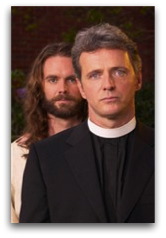
According to the Chicago Tribune:
Originally planned as a limited-run series of eight episodes, the controversial program about a pill-popping Episcopal priest with a troubled family has been pulled by NBC after airing for only three weeks. The series' ratings had not been great since its Jan. 6 debut, and the low ratings for the Jan. 20 outing of the show were the final straw. According to NBC, no further airings are planned.
I'm sure that there will be those who will criticize the Christian community for supposedly causing its cancellation. But I don't think we were the ones who killed it. It was practically stillborn to begin with. Besides all the ethical criticisms of the show, it primarily suffered from three things: bad writing, bad acting and Hollywood producers out of touch with the mainstream.
The demise of The Book of Daniel should come as no surprise. As I suggested in my initial review of the show, there was no way it could last for very long:
My hunch is that tonight's broadcast probably got decent, if not good ratings because of all the publicity the show received leading up to its debut. However, after that, the audience will begin to shrink. Add to that the time slot given to the show: 10 PM EST on Friday night. That has to be the worst time slot a show could receive.
My prediction is that by mid-spring, The Book of Daniel will be sealed for all of eternity (my apologies to ch. 12, v. 9 in the real Book of Daniel).
Mid-spring? Evidently I was too kind.
Two Ways to Subscribe to This Blog
You do have the option of subscribing to this blog, though. One easy way is to simply subscribe to the RSS feed. If you don't know how or don't want to do that, an even easier option is to enter your email address in the "NotifyList" form in the sidebar on the left. Once every week or so, I'll send out an update, but now the choice is in your hands and open to anyone reading this blog. You will NOT receive an alert with each new blog entry, but once every one to week at most.
A surprising number of people have already subscribed since I added the form a couple of days ago. You can also subscribe right here in this blog entry:
Rediscovering the Neighborhood Church, part 4
Barger was fairly critical of the megachurch as an entity that does not foster community. I'm going to try to straddle a fence here and not be quite so harsh on the megachurch as some are who share my perspective. I do not desire to disparage other ministries. One of the most common criticisms of megachurches is that their services are geared more to entertainment. To be fair, it's hard to create interactive, communal worship in stadium seating. It's also said that megachurches are more of a boomer phenomenon. I guess we'll see if that's true as all the generations get older. My hunch is that the Willows and Saddlebacks of the world were not created by human intention. Such enormous ministries grew unexpectedly under the feet of their leaders. I have grown through the writings and teachings of Warren, Hybels, Ortberg, Strobel, and others. I have gained insights at attending Willow's Leadership Conference more than once.
However, having said all that, I believe I can safely say that I don't want to be a part of a megachurch. And like Barger, I'm skeptical that it's the best thing for our communities as they often attract people who drive considerable distances to attend. From my perspective, instead of 20,000 folks meeting at a megachurch, I'd much rather see 80 neighborhood churches of 250 or so members spread throughout a city, especially if these churches can work in association with one another. I have been on church staffs and at times like right now, have been simply an active member. As a member, I do not desire to be in a church where I can't go to lunch with my pastor or other staff members every now and then. And I certainly don't want to be a member of a church where the pastor and I do not know each other. When that happens, the pastor is no longer in a pastoral role at all. Community has to take place from the top down.
How large is too large? Well, to put a number on it is to promote legalism. I don't want to do that. But when a church gets so large that members consistently look unfamiliar to other members it may be approaching those wider limits. If my pastor can no longer pastor me, or if I as pastor can no longer act as shepherd to the congregation, the size has become too large. Perhaps churches should consider all their options when they outgrow a particular site. The worst thing a church can do is relocate a significant distance away from an original site because of what its absence will do to the neighborhood community it leaves. Some will never be able to relocate, and the relocated church simply creates a spiritual vacuum for the abandoned community.
When a church begins to outgrow its present site, the best option may often be to send some of the best talent and the best leadership to a new church plant on the fringes of where the current membership lives thus creating a new neighborhood church. That doesn't mean simply creating a satellite church across town where members are commuting great distances and are not plugged into the local neighborhood. At the very least, members should be encouraged to eventually move into the neighborhood surrounding the new church, thus creating an indigenous mission force. And it also doesn't mean building a church in the backyard of a sister church. Although the idea of the parish is not official with most Protestant denominations, we should be respectful of ministries that are already ongoing in a particular neighborhood.
I wrote at the beginning of part 3 that many of us have gone about choosing our churches in the wrong way. We've sought out the biggest church, or the church with the most dynamic preacher, or the church with the most programs, while often neglecting the church that might be right within our own neighborhood ministering to the very people we should also be ministering to. I'm not suggesting that anyone leave their current church. But I am suggesting that in the future, if you find yourself looking for a church home, you should start with the general principle of which church is closest to you geographically. This will enable you to have those "random unplanned, unstructured encounters" with each other that Barger talked about. You will be able to be more involved, even in midweek ministry, because commute time is not an issue. And more importantly, you will see the same people at church that you see next door, and if you don't see them at church, you can be confident that you have the same interest in their well-being that your church does.
While I don't recommend that you change church membership, I might recommend that if you plan to stay at a particular church for the indefinite future, that you make plans to move closer to your church. How close you should be? How far is too far? As a general rule (and there are exceptions), I would say that walking distance is ideal, but a commute that is more than five miles is too far.
And don't live in an area solely based on proximity to work. I would recommend that it's better to live closer to your church than to work. A workplace often changes, but church life should be more stable. If, however, you can have all three together as my wife does, you are even better off. In fact, if you move to a new area, you have the option of finding a healthy church and then moving into its surrounding neighborhood.
Are there exceptions? Certainly. I'm not suggesting that the five-mile rule applies as significantly in rural communities. I grew up in a town of 20,000 people where there were a handful of prominent churches spread over town. All the advantages of a local neighborhood church would have applied to any of those churches. Also, there are still some places in our country where there aren't as many churches. Obviously, denominational loyalties will be a factor to many as well. I certainly understand that. I don't think this necessarily applies to the student or someone in an extremely temporary situation. Are you part of a church plant? Make efforts to move into the neighborhood of the new church within a reasonable amount of time. And pastors should gently encourage members to live within close proximity and question those who drive an extreme distance.
But I don't believe we should shop for churches the way we shop for a new car. The fact that you don't like a particular pastor's preaching style, or that the message didn't speak to you, is a really poor excuse. An "unfriendly church" isn't really a good excuse either. Perhaps you are being called to go to that "unfriendly church" and be friendly to all the visitors who might otherwise be turned away and thus set a good example for the current membership.
Certainly some might suggest that the church is called to be witnesses "in Jerusalem, Judea and Samaria, and to the remotest parts of the earth" (Acts 1:8). I agree with that. But a church's Jerusalem is the local neighborhood, it's parish, if you will. The people who live there--members, potential members, and those who will never be members--are a church's primary ministry obligation. Churches working with other churches in association in a community can be the Judea and Samaria. And denominations and mission organizations can reach the entire world through the people and resources the local churches provide.
My desire is not to be legalistic, but rather to foster community. I am suggesting general principles as a corrective to our modern dichotomized communities of neighborhood and church. I believe it's time to encourage people to bring these two together again as one community. I'm confident that one of the ways we can really reach people--one of the ways we can really reach the lost--is to offer them a stable, foundational environment through our churches. We can offer them a new family to help complete the turbulent and often dysfunctional families that exist behind the closed doors of our neighborhoods. We can offer them community in a way that no other affiliation can--one that is immediate, and powerful, and eternal.
Rediscovering the Neighborhood Church, part 3
In part 2 of "Rediscovering the Neighborhood Church," I brought up a schism that's been created by living in a neighborhood that's different from our church's neighborhood. This is a new phenomenon, the result of an increasingly mobile society that thinks nothing about driving across town to go to the movies, or to go shopping, or to go to school. So why not church, too?
In my previous discussion of this topic, I spoke of the disconnect that Kathy and I felt as we left our neighborhood, town, and even county, and drove elsewhere for spiritual community. It made no sense. We struggled with this for months, but we finally made the hard decision. In spite of the fact that we belonged to a great church, a church where we had been for a decade, a church where I had been on staff twice, we made the decision to move our membership to a body of believers in the town where we now live. In fact, we joined a church that is within walking distance of our house.
I'll never forget the first Sunday we visited, which incidentally, was a few weeks before we actually joined. Kathy and I were immediately welcomed by familiar faces. We saw people that were from our own neighborhood, who lived down the street. We were greeted by Kathy's co-workers. Children whom Kathy teaches ran up to her with smiles, yelling, "Mrs. Mansfield! Mrs. Mansfield!" I felt the immediate spiritual bond between geographic community and spiritual community. And for Kathy, there was added the third sphere of the workplace. I really don't think I had experienced that since my early twenties, since before we moved away from home. Before that day, I would have guessed that such a feeling of community was no longer possible in our modern world. But I was wrong.
Think about it for a minute. What missionary would try to reach one village, but live in a different village? That wouldn't happen very often unless he was the only missionary for miles around. So why do we do this with church? In every home in which I've ever lived during my adult life, I've felt like God placed me there for a purpose--to minister in that local neighborhood community. And yet, at the same time, every church sees as its mission to reach the people in its surrounding neighborhoods. For me, the two were never the same. Until this last year, I never realized the disconnect I was creating in my life and my church involvement. It's too much. It spreads a person too thin. Under such a self-imposed dichotomy, I don't have the help of a local body of believers to help me minister in my neighborhood. And just as bad, I don't have as much of a vested interest in my church's local neighborhood as I ought to. In fact, although I was very involved in my former church over the last decade, I had very little to do with the church's local neighborhood outside of the occasional "First Impressions" gift to new residents. I am ashamed to admit it, but I was never completely sold on my church's mission to reach the surrounding community. It wasn't something that I was conscious of though. I see it now because I've reflected on this, and I realize it was because I didn't live there.
A few months back I listened to a missionary home on furlough talk to a group of us who were her friends. She said that one thing she realized since being out of the country is that the church in the United States is too disconnected. We're traveling here and there, and we're not invested in our neighborhoods and each others' lives. She said one thing that Catholics had over Protestants was the old idea of the parish. Barger said the same thing in my quote from part 1. The parish. The Catholic Church has understood this for centuries. A region is broken up into parishes, and by and large members go to the church in their parish, in their local neighborhoods. They have community that transcends the church's walls because they see each other on their neighborhood blocks when the go for walks at night. They run into each other at the grocery store. The kids go to the same schools.
Protestants have never learned the lesson of the parish. In our desire to be independent, we build churches wherever we want--often in the backyard of an existing church. We put ourselves in consumer mode and "shop" for the church which we think will suit our needs best oblivious to the needs of the actual geographic community in which we live.
You know, I had a clue about this a few years ago. For a number of years, Kathy and I lived in a very urban neighborhood just about half a mile from downtown Louisville. It was a mixed neighborhood of blue-coller families who had lived on the same streets for two or three generations. Then, there were newcomers like us who were living in the remodeled shotgun houses. Tradition and trendiness were side by side. One thing I noticed soon after moving in was that the folks who had lived there all their lives, would go outside in the evenings and sit on their front steps, yelling conversations back and forth to one another across the street. So that we could do that, I pulled up the patch of ivy that was in front of our house (never liked ivy--a mosquito trap in my opinion) and laid down faux-brick patio stones and put a glider swing on top. Many nights we joined in the evening neighborhood cross-street conversations. But not often enough. There were many to minister to in this neighborhood, but we were involved in a church clear on the other side of the city in a neighborhood with a whole different mix of inhabitants.
Ironically, there was a church--a very small Baptist church--often pastored by seminary students, right on our block! They had a clothing closet that was open every Thursday, but they were a spiritual lighthouse in that neighborhood in a variety of ways all week long. I remember Kathy being invited to a baby shower for one of the young girls in our neighborhood held at that little church. This particular girl was pregnant without a father in the picture, again. Of course, regardless of the young woman's choices, her circumstances weren't the soon-to-be-born baby's fault. It wasn't the fault of her other toddler. Kathy was touched at how the church reached out to that young girl and her family. Despite her situation, the church saw to her physical needs and hoped and desired to tend to her spiritual needs as well.
Now, I don't relate any of that to diminish the church experience I had during those years. I wouldn't trade anything for the friendships I made, the ministry that I was involved in, and the help the church gave Kathy and me during some very difficult times. But now that I've been awakened to this issue, I never want to separate my neighborhood community from my church community again.
I have talked to so many people in the last year or two who tell me they feel disconnected from their church, often after being members in a particular church for a number of years. And I've talked to couples, often young couples, who can't find a church, but desperately desire a place where they can feel like they belong. I'm not saying that joining a neighborhood church will solve every difficult issue of fellowship facing the church today, but it's a start in the right direction--a very powerful start.
Tristan & Isolde

The story is basically one of forbidden love which is why the promoters have used the tagline, "Before Romeo & Juliet, There Was Tristan & Isolde." Well, that's true, and both stories are essentially tragedies, but that's where comparisons end. The aspect of forbidden love in this movie centers around Tristan's duty to deliver the woman he loves, Isolde, to his uncle, King Mark of Cornwall. This is a world of politically arranged marriages so Isolde, daughter of the Irish king, cannot simply refuse to marry Mark. She is bound to do so out of a sense of duty to her place and the supposed peace between the warring tribes that such a union will bring.
Now, if you're familiar with the original story, and you're expecting Tristan to rescue Isolde from a dragon and the two of them to fall under the spell of a witch's love potion, you will be disappointed. This telling of Tristan & Isolde is very much a "demythologized" version much like what First Knight was to the King Arthur legend or what The 13th Warrior was to Beowulf. I teasingly commented to Kathy on the way out of the theater that I was somewhat disappointed that there was no dragon. "There did not need to be a dragon in that movie! It would not have fit!" she exclaimed somewhat indignant that I would even make the suggestion.
Tristan is played by James Franco (Freaks & Geeks, Spider-Man). Franco is quite a good actor and definitely one we'll continue to see for some time. His trademark seems to be that saddened/hurt/betrayed/intensely introspective look that he carries throughout most of the movie, especially the second half. In the poster that I included above, he's almost smiling, but that's about the happiest you'll see him in this role. Sophia Miles plays Isolde (pronounced like it looks, by the way, but with a silent e). I had only seen Miles in Underworld before I saw this movie but she gives a fairly convincing performance. Perhaps the best performance was delivered by Rufus Sewell (Dark City, A Knight's Tale) who plays Tristan's Uncle, Lord Mark (later King Mark). Sewell is an extremely talented actor, but I'm so used to seeing him in roles as the villain that I assumed Mark was a bad guy in the first twenty or so minutes of this version of the tale. He's not.
I've heard very little buzz surrounding Tristan & Isolde. In fact, I never have seen a trailer on television (but I don't watch as much television as I used to), but rather first discovered the film on the Quicktime Movie Trailer website. I was interested in seeing it because of its literary connections and I also tend to enjoy period pieces. Having said that, I must confess that while the movies i good, it's not great. And I don't think it's done all that well at the box office. Indeed, it may be a film in search of an audience. Pardon my blatant sexist generality here, but with a tagline like "Before Romeo & Juliet, There Was Tristan & Isolde" you would think that the movie is targeting primarily a female audience. But When Harry Met Sally, this movie is not. There are a number of extremely violent scenes which is the primary reason it garners a PG-13 rating. I suppose, however, that guys out there could suggest this movie for a date night to look romantic and then later give a "who knew?" shrug during the fiercer battle scenes.
Tristan & Isolde is rated PG-13 "for intense battle sequences and some sexuality." There is no real nudity involved--lots of shots from the shoulders and up during the love scenes--but there is more blood than recent fare in movies such as the Lord of the Rings trilogy.
One last comment... I didn't know this until yesterday after looking up some of the history behind the original story, but evidently, Tristan may actually have been based on a real person in history. From the article in the Wikipedia:
A standing gravestone called the "Tristan Stone" near Fowey in Cornwall says simply enough in Latin 'Drustanus Hic Lacit Cunomori Filius' (Drustanus lies here, the son of Cunomorus). Interestingly, Cunomorus is the Latin name of King Mark of Cornwall, who in legend was Tristam's uncle and Iseult's husband ... Tristan may in fact have been a Pictish prince under a British King ... Under this explanation, the question arises of how the gravestone can be explained. One suggestion is that he could have been adopted into the family of Mark of Cornwall, which was an attested practice in Roman law.
Interesting...
Thanatos
sacrifices and libations will do you no good at all.
He has no altar; men do not sing him songs of praise.
Of all the gods Persuasion [πείθω] stays away only from him.
Aeschylus (525/4 - 456 BC), Niobe.
Cited in Anthology of Classical Myth by Trzaskoma, Smith, & Brunet.
Rediscovering the Neighborhood Church, part 2
But our struggle wasn't new. This was merely a new revelation about something that had been bothering us for a while. There were a number of factors involved.
I had become very disturbed over the previous year or more that my involvement at church, my church life, seemed much less central than it used to be. Church had always been a primary force in my life. Mom says Dad insisted that I go to church beginning when I was only two weeks old! Even during semi-rebellious teenage years, the church provided a solid ground in the midst of my self-induced chaos. As an adult I had a seminary degree and had been on a number of church staffs--so why was church less a part of my life than it had been in the past?
Well, it didn't happen overnight. Kathy had taken a position at the elementary school in Simpsonville, Kentucky, in 2003 and we eventually decided the best thing to do was to move to Shelby County, and I would be the one to commute back into Jefferson County for my work. Most of the earlier part of my life had been spent living outside the limits of Ruston, Louisiana, a town of roughly 20,000 people. Kathy and I moved to Louisville, Kentucky in 1991 and for well more than a decade lived in a very urban setting, at one point living only about half a mile from downtown itself. My mother-in-law had jokingly started calling me "City Boy" because I took to the urban setting and lifestyle so quickly and so well. Moving to Shelby County was almost like going back to my childhood. In such a rural setting, things moved much slower here. For the first few weeks, as I drove out of Louisville and headed to Simpsonville, I felt like I was leaving for vacation every evening.
Kathy and I had been part of the same church for practically a decade. I had been on staff there two different times. When we moved, we never thought twice about the distance we were putting between ourselves and our church. In practical terms, it did not seem all that much further than when we were driving across Louisville to go to church. People commute everywhere in urban areas--work, school, and even church. What's the big deal with a commute?
Well, it did turn out to be a big deal. If we hit traffic at the wrong time of day, we could spend up to an hour round trip just commuting. This wasn't an issue so much on Sunday; but often, with our cramped schedules, it made getting to midweek activities difficult. And there were psychological barriers, too. Maybe the actual miles weren't much further than driving across Louisville, but there was something about leaving one town, leaving one county and driving to another that sure made it feel much further.
The most important factor, though, was what was happening to us on a communal level after we moved. We were meeting our neighbors, and we were starting to interact more with the local town. We weren't just camping out for a while while Kathy had this particular teaching "gig." Rather, we were settling in to the community. Strange faces became familiar, and then we found they had names. I began to ask myself whether someone who lived down the street would be willing to visit my church in another city, in another county if I were to invite him? And I really began to struggle with that. I counted one day and realized that we passed seven churches on the way to our church--and that was before we even got on the interstate.
I had one of those light bulb moments. I realized that in our increasingly mobile culture--especially in urban areas--we as Christians have gone about choosing a church body in a very wrong way. And in doing so we've separated the community in which we live from the community we find in our churches. Historically, such a schism is a new phenomenon. Traditionally the two communities have always been synonymous. I believe this unnatural division is a very dangerous thing. Not only has it weakened the church, but I believe it has led to a growing feeling of disconnectedness I'm hearing about from so many Christians, even while they are in the midst of very sound and otherwise healthy churches.
In part three, I'll discuss this problem in greater detail and conclude this series by offering some practical solutions.
Alcimede's Grief
Anyway, I was reading Argonautica yesterday while waiting in the dentist's office. Who wants to read months-old magazines anyway? Anytime I read ancient literature, I am always struck by how different it is in form from modern literature. We as a culture are too impatient, and if we read at all, a work like Argonautica would never--in its present form--hit the bestseller's list--if it even got past an editor's desk to begin with. However, I love it. I love the way the story is told in an ebb and flow style that gives far more detail than what I'm accustomed to before returning back to the main thrust of the story.
Case in point is found in Book 1:260-277 (Loeb numbering) when Jason is about to lead his throng of heroes on their extremely desperate journey. Jason, the ever-popular hero, is surrounded by slaves and freemen, women and men as he prepares to depart. Apollonius paints quite the picture of despair as Jason's mother, Alcimede, wails and throws her arms around him, perhaps as a mother today might do as her own soldier son is leaving for Iraq. "And even as the mother had thrown her arms about her son, so she clung, weeping without stint [limitation]... ." Now, really, we get the picture, don't we? The mother's in tremendous grief that her son is going away on a seemingly doomed journey, possibly never to return. That description alone should be enough, shouldn't it? But Apollonius does not stop there. He creates the most telling and heart-wrenching analogy to describe her grief.
And even as the mother had thrown her arms about her son, so she clung, weeping without stint, as a maiden all alone weeps, falling fondly on the neck of her hoary [aged, white-haired] nurse, a maid who has now no others to care for her, but she drags on a weary life under a stepmother, who maltreats her continually with ever fresh insults, and as she weeps her heart within her is bound fast with misery, nor can she sob forth all the groans that struggle for utterance; so without stint wept Alchimede straining for her son in her arms, and in her yearning grief spake as follows... .
What an incredible description--although I have to admit that if a student in one of my writing classes turned in something like that, I would probably strike through the entire metaphor as being too much and too overdone. But again, different writing styles were appropriate for different eras in history.
Of course, you still have to wonder why Apollonius described Alchimede's grief for her departing son as that of a hopeless young orphaned girl mistreated by her abusive stepmother. I read the passage to Kathy and it jumped out at her, too. She wondered if Apollonius wasn't making a point regarding a particular situation with which he was familiar. Perhaps, but it's all speculation at this point--2,300 years later. Regardless, it's still good stuff for the reader who's willing to be patient and let the story unfold at its own pace. They definitely don't write them like this anymore...
Slow Down Week: Jan. 15 - 21, 2006
"Seven days without fast food, fast cars, or cheap thrills. Seven days of taking your time, breathing easy and making yourself at home."
This is another campaign from the Culture Jammers Network. I don't agree with all their political views, but I do like their TV Turnoff week (of course, the television is on as I write this). And I also like the sentiments expressed by Slow Down Week. On the site for this campaign, there are links to slow food, slow cities, slow lifestyle, slow design, and slow politics. A trio of recommended readings look interesting, too, but I just have so much to do this week...
Make sure you watch the Flash animation if you go to the site.
New Orleans Mayor Ray Nagin Has Officially Lost His Mind
Update (1/28/06): I didn't think it worthy of a separate blog entry, but I saw this cartoon at the Time Magazine website, and I had to add it to this entry.
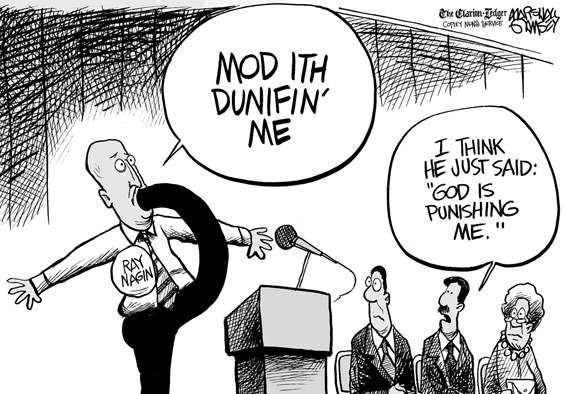
Rediscovering the Neighborhood Church, part 1
Ken Myers of Mars Hill had interviewed Ms. Barger regarding a book she had written for women. However, he included a second part of the interview on the CD's bonus track, entitled, "Why the Foodcourt at the Local Megachurch Isn't What Our Neighborhoods Need." That phrase actually never came up in the discussion, and must therefore be something that Myers thought of when he labeled the tracks. A number of people whom I've let listen to this interview get caught up on the megachurch issue, especially if they want to defend the idea of a megachurch. That's not my point in posting this here. I'm primarily interested in what Barger says about the place of the church in the local (literally local) neighborhood/community.
I have transcribed the portions of the interview that I thought were of value for my purposes here. If you would like to hear the interview in its entirety, it is available for listening online. Here is the transcribed excerpt that I think is most significant:
When I say community and we talk about community--local church community--I mean local. Local is not getting in the car once a week to drive fifteen miles across town to a megachurch that’s got five or six thousand people where you spend two hours there and go home.
That is not a community. That is an association. When I say community and I’m talking about local community, I’m talking within a very small geographic space. Because we are people who live in a small geographic space ... And I think it’s sad that we have gotten away from the neighborhood church, that people are driving miles all over to go to a huge church for two hours. The only way the church is going to be a redeeming community, active in the lives of people is when we get back to a very local model--smaller churches closer to where people live and work. That way we can integrate all of life.
I think it’s that medieval idea of the parish. I think that’s what we have to go to. I don’t think the megachurch is going to get us what we need. I think we need smaller and closer communities. I don’t think it’s [the megachurch] a good thing at all. I think it’s about performance and entertainment. And it’s not about pastoring and relationships and being close to where people live, where they sleep. I think the megachurch will never be able to do that. Because even if they say, "Well we’re going to have small groups," well, if you still have to drive ten miles to go to your Tuesday night small group meeting for another hour...
We need it [local church community] to be close enough that you have these kinds of random unplanned, unstructured encounters with each other.
We’ve got everything working against us. We’ve got sprawling suburbs. We’ve got automobiles that let us go anywhere we want to go. We’ve got communication--email and telephone--that gives us the illusion that we are still connected to each other. And we have forgotten the real need for physical presence.
In part 2, I want to look at the issue rediscovering the value of the local neighborhood church. I will interact with some of what Barger says, but primarily I want to focus on my personal journey and in then in part 3, offer some suggestions that just might help believers get connected with one another again.
Apple's New Slogan
"What's an Intel chip doing in a Mac? A whole lot more than it's ever done in a PC!"
The 2006 MacWorld Keynote: Viewing Between the Frames
I wasn't one of the fortunate ones able to sit in San Francisco to see and hear Steve live. I was one of the losers going back and forth between MacCentral and MacNN, constantly refreshing my screen for the updates. The video is now released in streaming Quicktime format, but too many people are hitting it and it's an exercise in frustration right now. Therefore, I'll write a few initial thoughts about today's revelations.
There was a lot of new information that Steve gave us, but as I read the updates, I felt like there was a lot we weren't hearing. This blog entry serves to "view between the frames" by giving you my speculation and hunches about some of what really was going on. I'm not trying to give an exhaustive examination of everything covered in the keynotes. There will be quite a few other sites doing that today. Here are just three three or so items that jumped out at me. If you agree or disagree, you're welcome to speculate with me in the comments below.


Second, anyone notice that the old comparisons between PowerPC processors and Intel processors are now officially a thing of the past. I mean the initial switch announcement surprised us anyway after we were told so many years that Macs with their PowerPC's were supposed to be so superior to Intel processors. And all those speed tests that made it look like Apple produced the fastest computers in the world! Now we're being told that the new iMacs are two to three times faster and the MacBook Pros are FOUR TIMES FASTER than the latest PowerBook revs. And if you go to Apple's site and look at the specs, these aren't even the fastest processors that Intel makes. Of course, the truth of it is that most currently manufactured processors are fast enough for the average application provided you have enough RAM and you aren't being slowed down by spyware and the Windows virus of the week. I'll be very interested to see what kind of specs are on whatever they call the replacements for the PowerMacs later this year. But now that the playing field has been leveled processor-wise between Apple and it's Windows cousins, processor speed comparisons will strictly be a thing of the past. But don't all of us Apple faithful feel like chumps now for believing what must've been a speed myth now that the new Macs are TWO TO THREE TIMES FASTER!
Third, is it just me, or does "MacBook Pro" seem like a clunky name? Is this just a bad take-off of the old WinBooks which was a take-off of PowerBook to begin with? How ironic. And will the iBook replacement merely be "MacBook" without the "Pro"? Like a friend of mine said, you'd think that with all of Apple's million dollar marketing geniuses, they could've come up with a better name than MacBook Pro.

What are your thoughts? Am I too suspicious or do you think there were a few corporate conspiracies in place, even if they were created just for the hype. Feel free to share your questions, thoughts, comments, and rebuttals.
This Is Not Your Father's Book of Daniel (Pun Intended)
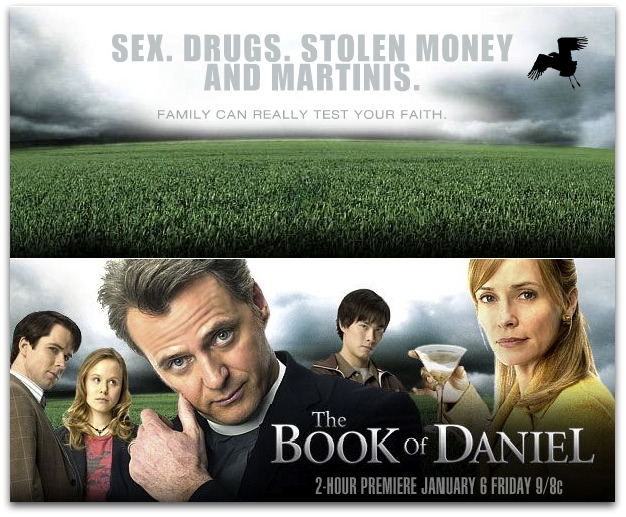
I remember hearing about The Book of Daniel almost a year ago. My guess is that it's been in production for a while, but may have been shelved for a time. I really don't know. Tonight NBC aired two episodes, the first of which must've been the pilot because hair lengths were different for some actors in the second hour (you know, they think we never notice such things). The show has garnered a lot of attention from a variety of circles, including negative reviews prior to its airing from groups like the American Family Association. I'm not sure how fair it is to condemn a television before it airs, and I naturally wondered if some of the negative buzz wasn't a bit exaggerated.
After watching the two episodes that aired tonight, I have to conclude that all the negative attention is not unwarranted. I tried to think of the best way to sum up the flavor of The Book of Daniel, and finally it hit me. How can I describe this show? Well, try mixing 7th Heaven with Desperate Housewives, and what do you get? Why, you get The Book of Daniel.
Here's the lowdown on the characters. I'll use the picture above and go from left to right.
Peter Webster (Christian Campbell): The gay son and oldest child of the show's main protagonist. Peter describes himself as being out of the closet, but not wanting to march in parades. Because his grandfather does not know he is gay, he allows himself to be set up with a young woman from church. Hilarity ensues in future episodes, I'm sure.
Grace Webster (Alison Pill): The only daughter. She's about 16, and shows talent as a potential manga artist. However, she needs money for software necessary for her craft, so she begins selling marijuana for which she gets arrested. Forced into community service, she meets another juvenile offender who agrees to download all the necessary software for her illegally from the internet in exchange for Grace's last bag of drugs.
Daniel Webster (Aidan Quinn): Episcopal Priest and main character. Webster comes across as fairly unsure of himself and his abilities, much like a new pastor fresh out of seminary rather than an experienced clergyman. He seems to have an addiction to prescription painkillers which he tends to take not for pain, but for stress. And he definitely has stress. His brother-in-law has run off with $3 million dollars of his church's money while his own family members have enough dysfunctions to fill any counselor's entire schedule. Fortunately (?) for him, he can talk directly to Jesus, who appears at regular intervals to him. Of course, in real life, if your pastor told you he had two-way conversations with Jesus, whom he could also see, you might want to call the men in the white coats. Quinn is a fairly decent actor, but in this role comes across as a poor man's Mel Gibson.
Adam Webster (Ivan Shaw): Adopted 16-year-old son, originally from China. Adam has quite the reputation as a ladies man and an out-of-control libido. He even propositions his sister at one point in the show, because as he explains it, they aren't actually related.
Judith Webster (Susanna Thompson): The supportive wife. There's not much to say about this character as the role was written fairly flat in the first two episodes, although she did seem to show a penchant for martinis.
Other Characters: Ellen Burstyn plays Dr. Beatrice Congreve who is the bishop overseeing (is that redundant?) Daniel Webster. She is very critical of a sermon of his in which he seems to condone giving into temptation, but later is shown to take a liking to Webster's prescription medicine. Toward the end of the second episode, we discover that she is sleeping with Webster's father (James Rebhorn) who is also a bishop. Of course, he's one of the most unlikable character's in the show, and the last person you'd want to have as your own minister. But his wife (Webster's mother) is suffering from Alzheimer's, which I suppose is why he feels free to cavort with Bishop Congreve. And then, there's Jesus, played by Garrett Dillahunt, whose portrayal reminded me more of a sixties hippie. I expected him to say "Far out, man" any second.
So what's the big deal? Well, there are a number of problems. In some circles people have praised this show because supposedly it depicts real life and the fact that no family is perfect. Well, I agree that no family is perfect, but the family in The Book of Daniel seems to be drawn more from families in daytime soap operas than the average family I know.
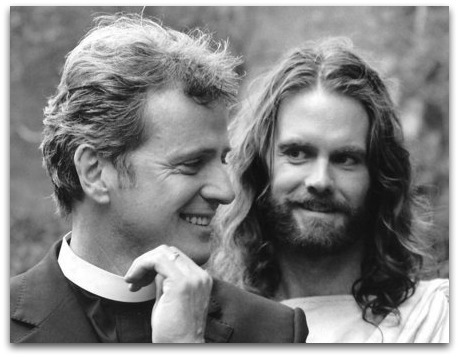
Early in tonight's pilot, the Rev. Webster (Quinn) guiltily rattles a bottle of Vicodin and informs Jesus (Garret Dillahunt) that he's got his consumption of pain-killers under control.
"Riiiight," says Jesus.
"Could you fit more judgment into that 'Riiiight'?" asks the reverend [sarcastically].
"Actually," replies Jesus, "yes, I could."
More examples? Homosexuality is declared to be genetic and normal, thus perpetuating this popular myth in spite of the fact that no studies have confirmed this with conclusive evidence. Also, during a subplot involving the reverend giving marriage counseling to a young couple, it's assumed that the two are living and sleeping together. "You mean you two are living in sin?" asks Webster. The man looks startled. "Just kidding!" says the reverend, slapping him on the shoulder. In the counseling session he even asks them about their sex life.
Nothing is condemned. When Webster is concerned over his adopted son's sex life, Jesus says "He a good kid. Let him be a kid." And that's the problem. Over and over similar statements are made. He's a good kid. She's a good woman. She's a good girl. When Webster objects to being rebuked by the bishop for his sermon affirming the benefits of sin (it makes us appreciate forgiveness more!), she responds with "Well, that's the business we're in." But if that's the business they're in, the business is going under.
The Book of Daniel is the brainchild of Jack Kenny, who has described himself in numerous interviews as an ex-Catholic gay man who has based the family in the show on that of his "life partner." Although he is not a practicing Christian, he says that he has respect for the religion. Really?
Consider for a minute that this show would have never seen airtime if it it revolved around a Muslim or a Buddhist family. Can you imagine a red-robed monk dialoguing with the Buddha? Or an imam engaged in conversation with a visual depiction of Muhammad? There would be jihad on Hollywood Boulevard over such.
And I don't think it's coincidental that Webster is an Episcopal priest. Of all denominations in the US, the average Episcopalian might be the least likely to object. And in fact, some have even praised the show for all the "positive" attention the Episcopal Church stands to receive. Like Jesus said in the first episode, "Riiiight."
As I mentioned earlier, I first heard about this show about a year ago. The context was surrounding a host of new programming the networks were considering in response to the favorable response toward Mel Gibson's The Passion. Surprised by America's reception of a movie that took spirituality seriously, Hollywood began searching for other spiritually related proposals previously snubbed. One of these was The Book of Daniel. They figured that if America would watch a whole film about Jesus, they would be willing to see him as a character on a weekly TV series. But all spirituality is not the same. And this is where Hollywood never gets it. The same core audience that went to see The Passion is not going to be interested in The Book of Daniel. And although it's being compared with Desparate Housewives, they're not going to attract those viewers either.
My hunch is that tonight's broadcast probably got decent, if not good ratings because of all the publicity the show received leading up to its debut. However, after that, the audience will begin to shrink. Add to that the time slot given to the show: 10 PM EST on Friday night. That has to be the worst time slot a show could receive.
My prediction is that by mid-spring, The Book of Daniel will be sealed for all of eternity (my apologies to ch. 12, v. 9 in the real Book of Daniel).
Promoting "Spiritual Death"?!
Over on the Baptistlife.com website, which purports to be "an online gathering place for Baptists," there's a link for seminaries. On that page a list of primarily CBF-affiliated Baptist seminaries are highlighted with the six SBC seminaries conveniently relegated to the bottom of the page.
In some very ironic mis-wording, perhaps some kind of bizarre Freudian slip, the Baptist Seminary of Kentucky is said to provide "theological education 'committed to spiritual death, intellectual honesty and moral integrity.'"

Spiritual death?! Committed to spiritual death? What would that mean? What would classes promoting spiritual death look like?
See the ad for yourself on the seminaries page, but do it quick before it's corrected. I mean... I assume it's a mistake.
UPDATE: The more I thought about this "typo," the more I was curious about it. So I went to BSK's website and tracked down the original quotation. On their About Us: MIssion page, they describe themselves as "committed to spiritual depth... ." Now that's just one letter off, but one letter sure makes a heckuva difference. Not to mention the fact that the letters A and P are on opposite sides of the keyboard.
UPDATE II: In the spirit of the Golden Rule (Luke 6:31), I thought it only proper to alert someone to this mistake. So I sent emails over the weekend to both the Baptist Seminary of Kentucky and Bruce Gourley who runs Baptistlife.com. The error has now been corrected.
Love Your God with All Your Mind: The Role of Reason in the Life of the Soul (Moreland)
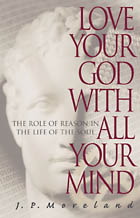
by J. P. Moreland
NavPress, 1997
Guest Review by J. T. McCubbin
I have sat through church services and listened to the outpouring of concern for lost souls. I have been bombarded with messages how, as a Christian, I should continue to seek ways to serve the unchurched in order to demonstrate Christ’s love through us, thereby appealing to the seeker in them, and further enhancing their curiosity about what should fill the obvious void in their life. There is certainly a thread of truth in this mindset, but something seems to miss the mark.
I have also overheard conversations from people at work and other social spheres, about how religion is a private matter to be kept to oneself and within one’s family. After all, what is right for one person is not necessarily right for another. Even we as “Christians” have no place telling, or even urging, others how to behave or believe.
The seeker-centered church presents multiple opportunities to invite my seeker friends and acquaintances to an entertaining church event where they will be exposed to the message of Christ. I don’t have to worry about the discomfort I might feel presenting the gospel to others. All that is required is to get them through the doors and allow the experience to take over from there. In these cases, I have repeatedly failed to fill the seats to which I have been allotted. Upon reflection it occurred to me, first, maybe I don’t have many friends, and second more importantly, I have no friends who are seeking.
Virtually everyone I encounter who is not a Christian has seemingly filled their void with a secular reality, with their individualism, with fulfillment from working toward, or achieving, their personal life goals, and developing the seven habits of overly-stressed people. They are confident in their life-experiences, and they are happy at having fun.
In reading J.P. Moreland’s, Love Your God With All Your Mind, something began to awaken; perhaps my soul even began to stir. After years of being lulled into “God said it, I believe it, and that’s good enough for me,” Moreland’s book passionately cries out for us to become mature Christians and use our minds--to take the first steps of a journey along a path not only to greater accountability, but also loving God in a way that we have long neglected.
Love Your God With All Your Mind: The Role of Reason in the Life of the Soul, is structured into four main parts:
Part One: Why the Mind Matters in Christianity
Part Two: How to Develop a Mature Christian Mind
Part Three: What a Mature Christian Mind Looks Like
Part Four: Guaranteeing a Future For the Christian Mind
In part one Moreland provides the framework for the spread of anti-intellectualism throughout the church and what the result has been. For example, this anti-intellectualism has led to a misunderstanding of the relationship between faith and reason.
While few would actually put it in these terms, faith is now understood as a blind act of will, a decision to believe something that is either independent of reason or that is a simple choice to believe while ignoring the paltry lack of evidence for what is believed. By contrast with this modern misunderstanding, biblically, faith is a power or skill to act in accordance with the nature of the kingdom of God, a trust in what we have reason to believe is true. Understood this way we see that faith is built on reason.
Part one continues by demonstrating how we have allowed our society, media, and education systems to marginalize Christianity. I recognized an example of this shortly after the latest government elections, where the media and late-night entertainers over-simplified the moral based political thought and defined Christian Conservatives as residents of Red states. From my personal experience, these Christians now accept the label and proudly display their newfound label on license plates and bumper stickers. They do not realize how they have allowed their entire belief system and spiritual faith to be wrapped up into a geographical color. This also assumes that because Christians might have morally-based thinking, that they are right-wing conservatives--another set of labels.
Part one also recognizes the reluctance that many Christians might have with a more intellectual structure to a Christian life. Moreland adequately deals with five common misconceptions about a Christian intellectual approach, allowing the remainder of the book to unfold unimpeded.
Part two deals with what Moreland calls the “Hobgoblins, Thieves, and Cobwebs” of our Christian minds. These are the mental enemies we struggle with and how we can begin to gain the upper hand. Dealing with the cobwebs, we dust off our own understanding of reason, logic, and recognizing false argument.
One of the most serious Hobgoblins Moreland contends with is the Empty Self. Reading through the characteristics of the Empty Self, one will recognize many traits indicative of members of our culture. More convicting, one may also recognize traits found within themselves. Overcoming this Empty Self with a “careful intellect,” Moreland argues, is the first step in cultivating a Christian mind.
In the third part Moreland deals with cultivating the Christian mind with a heavy dose of apologetics, and how it can find its place in evangelism. Well-founded apologetic reasoning can then be used to answer the skeptic, the moral relativist, and the philosophical naturalist (scientism). Even for the thought-novice like myself who still has to muster up the courage to rhetorically engage others, understanding these cultural pitfalls allows us to more readily recognize them in our workplace, social circles, and in the entertainment we choose for our family and ourselves.
Finally, in part four Moreland contends with the future of the church with suggestions for recapturing the intellectual life of the church. While in the first three sections, Moreland articulately and appropriately argues for the need for such a recapturing, the suggestions outlined in the fourth section seem to suffer from a superficial element. The suggestions themselves are worth consideration, but only scratch the surface of what may more appropriately require something close to a complete re-engineering. Where the fourth section is redeemed is in the following two appendices full of additional resources for further study. While not diving into these appendices directly, Moreland’s book has more than inspired me to keep studying, digging, reading, and thinking.
For me, Love Your God With All Your Mind has served as a jumping off point into other introductory philosophical reading that has helped me understand the origins of much of today’s flawed secular thinking.
J. T. McCubbin can be contacted at JT.McCubbin@hexionchem.com.
Rick's note: In my opinion, this is one of the most significant books I've read in the last five years. Don't let the title fool you; Moreland's book is not a call to an Ivory-towered, private academic study. Rather, it's a call to Christians in our culture to a life of serious discipleship that among other things, will prepare the believer for encounters with those outside the walls of the church.
The Divorce Rate: It's Not As Bad As You've Heard
Consider this evaluation from Bible.org:
How many times have you heard or read that 50 percent of U.S. marriages end in divorce? It’s not true. Yes, the number of divorces each year is about half the number of marriages that same year. But that’s like computing the death rate by comparing the number of people who die with the number of people who are born.
That ignores those who neither were born nor died during that 12-month period. The 50-percent divorce figure ignores the number of intact marriages from years and decades earlier. The truth is that about one of 50 marriages ends each year, according to the National Center for Health Statistics. Pollster Louis Harris maintains that 90 percent of marriages survive until one partner dies.
Daniel Lynch, American Journalism Review, quoted in Reader’s Digest, p. 90
As tragic as divorce is, not everybody's doing it.
Martin Luther Was Excommunicated on This Day and Why I Love the Encyclopedia Britannica
I have always loved encyclopedias. When I was a child I grew up with a set of 1967 World Book Encyclopedias in our house. These were bought the year I was born from my grandmother, who used to sell them to supplement her elementary school teacher income. I didn't just use them to plagiarize school reports like all the other kids; rather, I would sit and read them for hours, like a good book. Often I started with one article that I was interested in, but the "see also's" would take hold of me, and before I knew it, I was surrounded by stacks of the various volumes.

Kathy on the other hand, as a children's librarian hates the Encyclopedia Britannica because she says its reading level is too high, it doesn't have enough pictures, and it doesn't have enough pictures in color. Plus, she says, physical encyclopedia sets go out of date too quickly, and she's thrown away dozens of sets over her career (I shudder to even think of such things). Of course, I counter that we don't have children yet, so I don't want an encyclopedia set for them--I want it for myself. And going out of date isn't an issue because of yearbooks, not to mention the fact that most of my interests are of a historical nature and therefore, won't go out of date. She'll eventually counter with, "Well, we can't afford it right now," and I have no real argument for that one.
You're wondering when Martin Luther is going to come into this, aren't you?
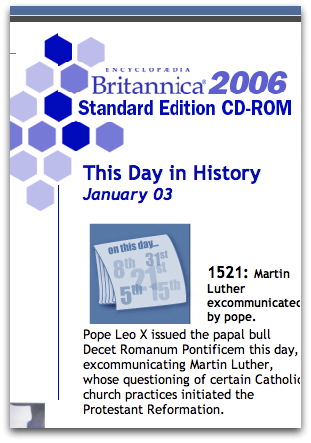
Needless to say, she ordered it and gave it to me for Christmas. Maybe it was only $10, but it is one of my favorite gifts. I've already found myself lost in the "see also's," bounding from one article to the next, but this time without books stacking up around me. It's wonderful having it on my computer with so much information at my fingertips whether I'm online or not. Isn't this what computers were made for? I still want the print set one day, mind you (I'll fight that battle later), but for right now, the CDROM version of Britannica will do. In fact, it lets me install the whole thing on my computer, so I don't even have to carry the disks around.
So anyway, this afternoon I fired up it my to make sure I was right about brontosauruses never existing for my King Kong movie review (see the previous entry) and I happened to notice on the main interface that the "This Day in History" was all about Martin Luther's excommunication. Wow. I mean, how could this program even know I would be interested in such things? I know, I know...I'm sure it was just a random selection from history, but for a moment I felt as if the program had scoured my hard drive looking for things I'm interested in.
That led me to wonder what kind of article Britannica had on Martin Luther, so I looked him up. In addition to the main article, the software informed me that over 1900 articles made reference to Martin Luther, although undoubtedly many refer to Martin Luther King Jr. However, even with a quick sweep of the other articles I saw entries on "Conflict with Luther (from Leo X)"; "Relations with Luther (from Zwingli, Huldrych)"; "Worms, Diet of"; "Frederick III"; "Schmalkaldic Articles"; and hundreds of others.

I was curious as to the length of the article since it is hard to tell looking at a computer screen. So I copied and pasted it into a word processor. With a 12 point, single-spaced Arial font, it came out to 22 pages. That's not too bad for an encyclopedia article in my opinion. As for the information about the event in today's history that caught my eye, Professor Rupp had this to say:
In January 1521 the pope issued the bull of formal excommunication (Decet Romanum Pontificem), though it was some months before the condemnation was received throughout Germany. Meanwhile, the imperial Diet was meeting at Worms, and there was a good deal of lobbying for and against Luther. In the end, Frederick the Wise obtained a promise from the emperor that Luther should not be condemned unheard and should be summoned to appear before the Diet. This enraged Aleandro, who asserted that the papal condemnation was sufficient and that the secular arm had only to carry out its orders. It also alarmed Luther's friends, who did what they could to dissuade him. Luther was firm in his determination to go, and began the journey in April 1521, undeterred by the news, on the way, that the emperor had ordered his books to be burned. What was meant to be the safe custody of a heretic turned out to be something like a triumphal procession, and when Luther entered Worms on April 16 he was attended by a cavalcade of German knights and the streets were so thronged as to enrage his enemies.
The Decet Romanum Pontificem is indexed so as to link to the Luther article and to the article on Leo X.
Thanks for my gift, Kathy, and letting me get lost in the "see also's" once again...until we get the print version one day....
Kong

Peter Jackson's Reward. King Kong was Peter Jackson's reward movie. After making a kabillion dollars with the Lord of the Rings trilogy, Peter Jackson could make any movie he wanted to. King Kong was the movie he wanted to make since it was his favorite (the original 1933 version, not the 1976 remake with Jessica Lange) as a child. However, not only was he rewarded with the opportunity to make any movie he wanted to, he also got paid $20 million dollars to direct King Kong, the most money any director has ever been paid. Jackson is now the new Steven Spielberg, so I guess we can start expecting his movies to get snubbed at the Oscars, too. Further, as long as Jackson has a string of successful hits, I imagine he will continue to get to make whatever movies he wants. I've heard rumors that The Hobbit is coming soon. I hope so.

Fay Wray's Almost Appearance. Evidently, the 1933 Ann, Fay Wray was originally supposed to say the last line of the movie, "It wasn't the airplanes; it was beauty that killed the beast." Unfortunately, she died in 2004 before they could film/record her saying this. The movie is dedicated to her memory.
The Movie is LONG. Yes, this movie is fairly long at 187 minutes. This has been a criticism of the film as Jackson has been accused of being so in love with the film that he didn't know where to cut it. According to the trivia page at the IMDB site for the movie, many of the exact lines, costumes and props that were in the original went into this movie. Further, the entire first act of the movie, set in New York, is provided as back story and was never in the 1933 version. Once I saw dinosaurs on Skull Island, the little boy in me took over, and I think I could have sat there for six hours. However, my personal opinion is that in any film that is three hours or longer ought to have a five-minute intermission. I had to excuse myself to the restroom twice--TWICE--during this movie. I haven't had to do that since Return of the King. Hmmmm...
Can This Relationship Work When He Has All the Manners of an Ape? Yes, the relationship between Kong and Ann seems a bit bizarre. And yet, I must confess--perhaps it's good acting on Watts' part and good directing from Jackson--the two of them actually had chemistry together. I don't mean that in some kind of perverted sense, but perhaps more in the sense of the genuine affection between a pet and its owner. Of course, with Kong and Ann, I'm not sure which was which. But there were some very moving scenes between the two of them such as when she chooses to let him be her defender from the tyrannosaurus rex or when they "danced" together in Central Park. But such relationships are doomed to fail, especially when others are firing bazookas at you. By the way, I'm assuming you know how the movie ends, but Kathy had never seen either of the previous versions, and she cried at the end. "You mean, he's not going to get to go back to Skull Island?" Actually, she cried a couple of times during the movie. That's how well the chemistry between Kong and Ann is portrayed.

[By the way, note to parents: take the PG-13 rating seriously. Some of the scenes, especially on Skull Island, are going to be too intense for young children. I saw more than one parent take their children out of the movie.]
What's the Point of the Movie? I was thinking about this even before I went into see the film. What exactly is the point of King Kong? Yes, "it was beauty that killed the beast," but in the end, so what?I mean with Jurassic Park, there was definitely an ethical angle to the movie about setting self-imposed limits to what we can do with technology. And I'm sure some animal activist group will seize upon the picture as an example of why animals should be left in the wild and not put on display. But that was certainly not the message that Jackson was presenting in the movie. Perhaps not every movie has to have a message. Perhaps this movie can allow someone such as myself to occasionally put aside critical thinking and just let that little boy that's still in me somewhere be entertained. King Kong did that for me, and as much as I enjoy movies, very few of them do anymore.
Life Together (Bonhoeffer)
by Dietrich Bonhoeffer
Current edition: © 1979, Harper Collins Publishers
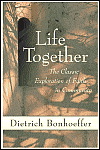
As noted, the book is fairly short--only 128 pages. It's divided into five sections:
1. Community
2. The Day with Others
3. The Day Alone
4. Ministry
5. Confession and Communion
In the first section, Bonhoeffer lays out a theological foundation for Christian community beginning with a quotation from Psalm 133: "Behold, how good and how pleasant it is for brethren to dwell together in unit!" (v. 1). And although starting from an Old Testament reference, the source for Christian community is demonstrated to be in the person and resurrection of Jesus Christ.
Christian brotherhood is not an ideal which we must realize; it is rather a reality created by God in Christ in which we may participate. The more clearly we learn to recognize that the ground and strength and promise of our fellowship is in Jesus Christ alone, the more serenely shall we think of our fellowship and pray and hope for it. (p. 30).
In the second section on the day with others, Bonhoeffer describes how the day should be started when living in community--what he calls common devotions. These common devotions are broken down into Scripture reading, singing together and prayer. Bonhoeffer creates a guide as to how each of these components can be facilitated allowing them to work together. Further, such common devotions should be done before breakfast, what he calls "the Fellowship of the Table." Bonhoeffer goes on to describe how this benefits the days work, and his assumption is that the community or family will be able to join together again for a meal at noon and the end of the day.
Lest anyone should become dependent upon the community as the sole avenue of the spiritual life, Bonhoeffer also has a chapter on individual disciplines, "The Day Alone." See my previous post for a quotation from this chapter where he points out the danger of neglecting community or spending too much time in community. As with all things, there must be a certain amount of balance or moderation. Bonhoeffer goes on to discuss the importance of the individual believer's need for meditation on the scriptures, prayer and intercession.
I was especially intrigued by Bonhoeffer's chapter on ministry. This is without a doubt a chapter that every pastor and Christian counselor should pay close attention. Bonhoeffer was probably writing primarily with the pastor of a church in mind, but I believe his message applies to anyone in a position of spiritual leadership. He has a section entitled "the Ministry of Holding One's Tongue" and another on "The Ministry of Meekness." These sections serve to remind the person in spiritual responsibility of the privilege that it is to work in service to the Christian community. He follows these with a section on "the Ministry of Listening." Here, Bonhoeffer states the following:
The first service that one owes to others in the fellowship consists in listening to them. Just as love to God begins with listening to His Word, so the beginning of love for the brethren is learning to listen to them. It is God's love for us that He not only gives us His Word but also lends us His ear. So it is His work that we do for our brother when we learn to listen to him. Christians, especially ministers, so often think they must always contribute something when they are in the company of others, that this is the one service they have to render. They forget that listening can be a greater service than speakingl (p. 97, emphasis added).
I was also touched by Bonhoeffer's words in his section, "The Ministry of Bearing": "It is only when he is a burden that another person is really a brother and not merely an object to be manipulated" (p. 100).
In the final section on confession, Bonhoeffer seemed to be way ahead of his time on this subject. Way before Promise Keepers or related accountability groups, Bonhoeffer wrote, "He who is alone with his sin is utterly alone" (p. 110) and "If a Christian is in the fellowship of confession with a brother he will never be alone again, anywhere" (p. 115). Of course, he really wasn't introducing anything new at all, but rather reintroducing the value of confession (perhaps lost in reaction to the Catholic Church after the Reformation) and the reality that the average person in sin needs only forgiveness from on high and the firm and loving support of close friends.
If you've ever read The Cost of Discipleship, this books seems to be a natural follow-up, although it is very different in both tone and scope. According to the introduction, Bonhoeffer wrote both books during the same period in his life, so the one naturally flows into the other.
The book was especially meaningful to me because the two areas of concern I have for the church today--and the two areas where I feel I can most contribute--are discipleship and community. These are not something the church has always done well, but something we are called to do, and when done well can be a dramatic foretaste of eternity to come. From conversations I have had over the last year, and from ongoing conversations, community seems to be one of the most sought after, and yet the most elusive gifts the church has to offer. However, if made a priority, community can be a steadfast offering from the church to an ever-changing world. I will be writing more on this subject, including my own journey, in this new year.
One final note. I obtained my copy of Life Together used. There is a personal note written in it, not inside the cover where you might expect it, but on the page facing the first chapter. It is dated September 3, 1998. It reads, "With the prayerful hope that you will find and join and build Christian community. Love Dad." What does it mean that a little over seven years ago a father placed this book in his son's hands and now his son doesn't have it anymore? I don't know. It somehow seems a bit sad. But maybe it can be encouragement for all of us concerned about such things to help fulfill this anonymous father's wish.










